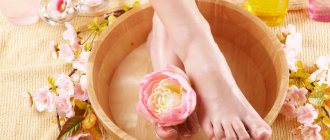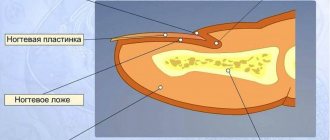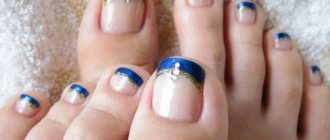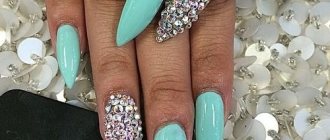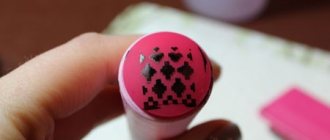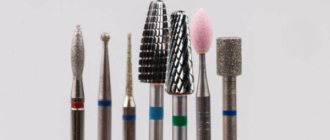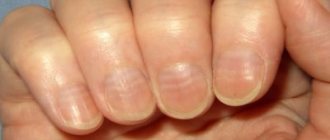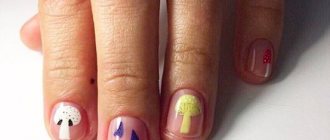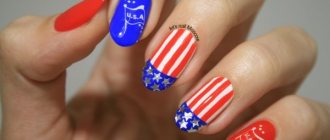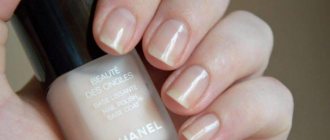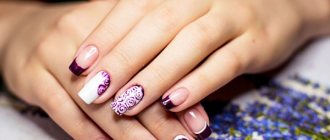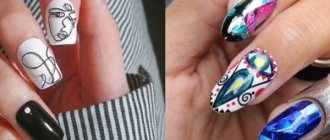It is impossible to imagine a modern, well-groomed woman without well-groomed toenails. It is not necessary to have a professional manicure and pedicure. It is enough to know how to correctly and how often to perform the procedure yourself at home. When performing it on your own, it is important to study the step-by-step instructions and familiarize yourself with the list of contraindications for the procedure. You shouldn't do a pedicure too often, but doing a pedicure too rarely will lead to roughening of the nail plates, proliferation of microbes, and the appearance of fungus.
Pedicure in salon conditions
No matter how much I moisturize my feet, they constantly dry out and crack. What to do?
If the problem is such a global one, then it is a matter of a general lack of fluid in the body. Try to drink more liquid per day (at least 2 liters), and change light moisturizers to nourishing ones (CLARINS has an excellent product!). And here’s another little secret: every night, lubricating your feet with a thick layer of cream, put it on top socks - this will create a bath effect, and nutrients will penetrate deeper into the skin.
Medical pedicure training
There are few podiatrists with medical education and sufficient knowledge in the field of podology in Russia. Full training, including the basics of medicine and the narrow specialization of a podologist, is carried out in Canada and the USA.
Courses that promise to teach the work of a podiatrist and issue certificates will not help the master when meeting with Rospotrebnador - when he sees medical pedicure in the list of services, the inspector will definitely ask for a document on medical education, as well as a license to carry out medical activities.
What you need to know about salon or office inspections
It is advisable to attend such courses if you have a medical education, and podology will become an advanced training. If this is the case, then you don’t have to be afraid of meeting with the SES. There are several institutions in Russia that expand the knowledge of certified physicians who have decided to engage in medical pedicure:
Institute of Podology
The organization is located in Moscow and offers more than two dozen areas in the field of podology. The duration of the courses is from 1 day to 3 months. Upon completion of training, a certificate is issued.
The cost of training is from 5 to 35 thousand rubles. Please note that high-quality presentation of material and subsequent competent testing of knowledge cannot be cheap. A good specialist always sensibly assesses his qualifications.
First long-term care center
The training center is located in Yekaterinburg. Students are encouraged to acquire knowledge about correcting ingrown toenails using different techniques and materials. In addition, the company organizes seminars where listeners learn about foot diseases, the structure of the skin of the feet and other basic information.
The cost of training is from 4 to 15 thousand rubles.
Nadlen Nail
Beauty salon Nadlen Nail has its own school where medical pedicure courses are held. The company has 4 programs in its arsenal. Duration of training is from 1 to 3 days. Cost – from 15 to 37 thousand rubles.
Manicurist training - how to choose a school
How often should you get a pedicure?
And here again there is no single option. As a rule, specialists advise contacting them at least once every 3-4 weeks. But if you have soft and moisturized skin that does not require regular care, you don’t need to go that often. Visit a specialist as needed as soon as your feet begin to harden.
What are the dangers of rare visits to a manicurist and pedicurist?
It is difficult to determine the optimal number of manicure visits for everyone: it directly depends on the individual skin and characteristics of each person’s nails. For some, it is acceptable to do the procedure once a month, and for others, once every 10-14 days.
Masters recommend not to forget about your hands, because subsequently processing the cuticle will take much longer.
The coating, which has grown strongly, puts strong pressure on the free edge, so breaks appear - places that are most conducive to the growth of various bacteria.
In addition, very long wearing of an unrenewed coating contributes to the thinning of the nail plate.
Is gel polish harmful? How long can you walk with it without taking it off?
Nails are damaged by improper care, careless removal of the coating or insufficient hygiene. And the varnish itself is not at all dangerous - of course, if it is applied to healthy nail plates. With serious wounds, bruises, or fungus, you need to go to a doctor, and not to a pedicurist. The quality of the coating, by the way, also affects the health of the nails. Therefore, we advise you to choose quality products, like varnish from ARTDECO.
The length of time you wear the coating depends on how quickly your nails grow. Some have to renew the varnish once every 2-3 weeks, others - once every 1.5-2 months. The belief that nails should “breathe” is a myth. Therefore, the need for correction is a purely aesthetic issue.
Pedicure is more than just nails
Many people believe that a pedicure is just covering the nails with decorative varnish. But the concept is much broader and includes several procedures:
- Removal of keratinized areas.
- Treatment of cracked heels.
- Removal of dry calluses, corns, core calluses.
- Correction of the shape of nail plates.
- Cuticle removal.
- Processing of side rollers.
- Treatment of ingrown nails.
- Foot massage.
- Treatment of nail and skin fungus.
- Nourishes and moisturizes the skin, strengthens nails.
Carry out the procedure in a salon with a specialist: this way you can be sure that corns, ingrown nails, and inflammation of the nail folds will no longer bother you. People with sensitive skin, brittle nails, diabetes, fungal infections of the skin and nails cannot do without professional help - only a podiatrist can perform a pedicure in this category.
Where do calluses and other foot skin problems come from?
There are two reasons: genetics and uncomfortable shoes. In the first case, corns and calluses appear due to the fact that the skin is thin and easily injured by any mechanical impact. And in the second, we advise you to always carefully choose new shoes or sneakers. And not just try them on and run to the checkout, but, at a minimum, walk back and forth around the store.
Pedicure: benefits and harms
If all procedures are performed by a qualified specialist using modern equipment, a pedicure can only be beneficial. Otherwise, if done incorrectly, you can damage the skin, cause infection, etc. Therefore, when choosing a beauty salon, pay attention to the qualifications of the specialists working there.
Is it true that you shouldn’t use hard files often—this makes your skin even rougher?
Alas, yes. Harsh abrasives injure the skin - and because of this, it regenerates faster and, therefore, becomes rougher faster. Therefore, we advise you to choose peelings based on fruit acids rather than files to remove dead particles - here is an excellent example from L'ETOILE. And then be sure to moisturize your feet with cream - GREEN MAMA has a budget product with sage and linseed oil.
In general, home remedies and tools are sufficient for basic foot care. So you don’t have to spend money on the services of a specialist every few weeks to get a beautiful pedicure.
Why do you need to get pedicures all the time?
Often girls neglect the rules of periodic repeated pedicure corrections, since they do not consider it necessary to constantly care for the sensitive skin of their feet. The main reason is careful skin care. There are a large number of nerve endings and capillaries on the girl’s feet, so the area is very sensitive, which is why it needs to be carefully looked after. Since the cosmetic procedure includes a small massage, it helps to renew the functioning of the entire body, restore the activity of individual organs and increase the client’s immunity.
In addition, periodic and frequent relaxation technology helps to avoid stress and depression, which is associated with the complete restoration of the nervous system by exfoliating nerve points and pores on the feet, which increases their sensitivity.
However, you can shorten the period of repeated manipulations if you take care of the delicate area yourself at home. To do this, you need to prevent the aggressive effects of external factors by following additional care recommendations:
- Use a pumice stone while showering to exfoliate rough skin.
- After washing, dry the fabric completely to prevent the formation of mildew associated with high humidity.
- At night, use moisturizer, spreading it evenly over your feet.
- Do caring procedures 1-2 times a week: masks, baths, oils, solutions - they help maintain the quality of the tissues.
- Avoid frequent wearing of cheap, uncomfortable shoes. It promotes friction of the epidermis and increased sweating, which clogs the pores on the legs, making them less sensitive.
- Drink plenty of clean water. It helps remove toxins from the body, preventing them from depositing in the limbs, which causes them to swell and slow metabolism.
To increase immunity, in the warm season it is recommended to walk a lot with bare feet on sand, stones, and grass. This has a positive effect on metabolism and normal blood circulation.
Maintaining the health and visual condition of the skin significantly increases a girl’s self-esteem; she feels more confident, since she can always take off her shoes, wear open shoes, without hiding certain parts of her body in front of others.
To choose the frequency of performing the technique, take into account the condition and health of your feet so that they always look neat and fresh.
Expert opinions on hardware pedicure
Nail service experts consider hardware pedicure an excellent alternative to trimming, since it does not damage the living layers of the skin, but only removes rough ones. Here is how Marina, a top manicure and pedicure specialist, speaks about the procedure: “Classic pedicure traumatizes the skin, after which the corns begin to grow again with a vengeance. Treatment with the device allows you to remove only dead epithelium, the smooth effect lasts many times longer. Regularity is an important point. If you do pedicures regularly, after a couple of months your legs will noticeably transform. In addition, hardware pedicure is great for pregnant women and people with diabetes.”
What is a hardware pedicure
Hardware pedicure is a mechanical treatment of the skin of the foot, nails and toes using a special grinding tool with cutters and various attachments. The device, due to the rapid rotation of the cap, safely removes keratinized epithelium, corrects the nail bed, polishes the nail plates and removes cuticles.
The pedicure device has several operating modes, adjustable to different power and speed depending on the condition of the skin. After each session, removable attachments are treated with an antiseptic, ensuring absolute hygiene.
Features of hardware pedicure
The main feature of this treatment is the treatment of dry skin without prior steaming. The dead layer of epithelium is removed gradually in exactly the amount that is acceptable for the current condition of the feet.
Other features include:
- efficiency - different attachments not only tidy up nails, but also remove corns and calluses, leaving the skin smooth and soft;
- versatility - the device can be used even on sensitive skin without the risk of damage or fungal infection;
- the presence of a professional master - only a trained master can carry out the procedure correctly;
- therapeutic effect - hardware care eliminates cracks and ingrown nails.
Types of hardware pedicure
There are several types of hardware pedicure, differing from each other either in the method of processing cuticles or in the number of additional cosmetic procedures.
Classic pedicure
Classic treatment includes standard treatment of the sole of the foot, skin folds, fingers and toenails with rotating caps. Dead epithelium and cuticle are removed, a nail bed is formed, the surface of the nail is polished, after which a decorative or medicinal coating is applied to it. Finally, the leather is treated with finishing agents.
Unedged pedicure
Since all hardware pedicures are essentially unedged, this term is more of a nominative nature. During the procedure, the cuticle is not processed by the device, but is only moved with a wooden stick. To make it more pliable, the master first lubricates the surface with softening oils, and only then forms the nail bed.
This type of care prevents damage to healthy skin, but the effect does not last long: after just 2 weeks, the cuticles again look untidy and require treatment. If pushing back and softening with oils is carried out systematically, a cumulative effect is achieved - the cuticles become softer.
SPA pedicure
The essence of the procedure is relaxation after a hardware pedicure. When the treatment of feet and nails is completed, the following is done:
- foot baths with the addition of flavored oils, plant extracts, sea salts, thermal waters;
- peelings with natural scrub;
- various masks based on natural ingredients, vitamin complexes;
- relaxing massage.
